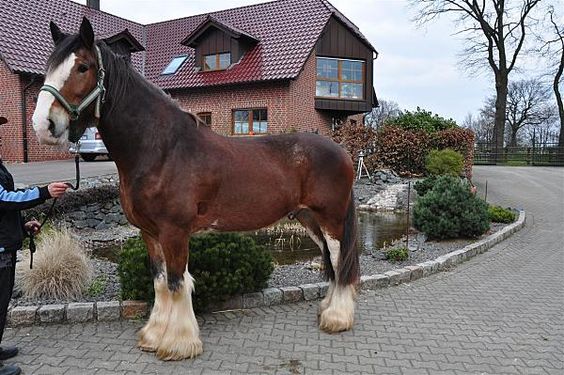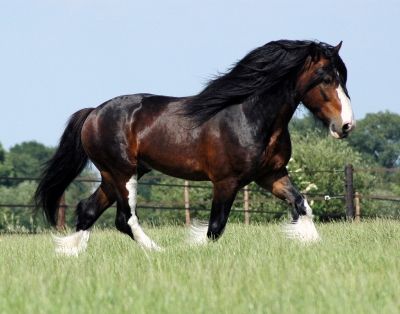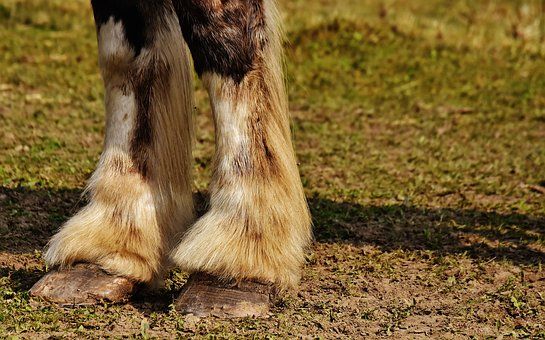Travel the world
Climb the mountains
Post Page Advertisement [Top]
AnimalsHorsesPets and Pets
Shire | Horse Breed | History,Characteristics,Uses and Other Information
The Shire is a British breed of draught horse. It is usually black, bay, or grey. It is a tall breed, and Shires have at various times held world records both for the largest horse and for the tallest horse. The Shire has a great capacity for weight-pulling, and has been popular throughout its history for pulling brewer's drays delivering ale to customers. The horses may also be used for forestry, for riding and for commercial promotion.
In 1878, the British organisation now known as the Shire Horse Society was created, with the American Shire Horse Association beginning in 1885. The breed was exported from Britain to the United States in large numbers during the late 19th and early 20th centuries, but popularity fell as mechanisation increased, reaching a low point in the 1950s and 1960s. Popularity began to increase again in the 1970s and after. However, population numbers are still considered to be at critical levels by both the UK-based Rare Breeds Survival Trust and the US-based American Livestock Breeds Conservancy.
History
Though oxen were used for most farm work into the 18th century, horses 'fit for the dray, the plough, or the chariot' were on sale at Smithfield Market in London as early as 1145.The English Great Horse was valued during the reign of Henry VIII, when stallions measuring less than 'fifteen handfuls' could not be kept, but the increasing role of gunpowder brought an end to the use of heavy horses in battle. Oliver Cromwell's cavalry favoured lighter, faster mounts and the big horses began to be used for draught work instead.During the 16th century, Dutch engineers brought Friesian horses with them when they came to England to drain the fens, and these horses probably had a significant influence on what became the Shire breed.
From this mediaeval horse came an animal called the Old English Black Horse in the 17th century. The Black Horse was improved by the followers of Robert Bakewell, of Dishley Grange in Leicestershire,resulting in a horse sometimes known as the "Bakewell Black".Bakewell imported six Dutch or Flanders mares, notable since breeders tended to concentrate on improving the male line. Two different types of black horses developed: the Fen or Lincolnshire type and the Leicester or Midlands type.The Fen type tended to be larger, with more bone and extra hair, while the Midlands type tended to have more endurance while being of a finer appearance.The term "Shire horse" was first used in the mid-17th century, and incomplete records begin to appear near the end of the 18th century. The "Packington Blind Horse", from Leicestershire, is one of the best-known horses of the era, with direct descendants being recorded from 1770 to 1832.This horse is usually recognised as the foundation stallion for the Shire breed, and he stood at stud from 1755 to 1770.During the 19th century, Shires were used extensively as cart horses to move goods from the docks through the cities and countryside. The rough roads created a need for large horses with extensive musculature.
In 1878, the English Cart Horse Society was formed, and in 1884 changed its name to the Shire Horse Society. The Society published a stud book, with the first edition in 1878 containing 2,381 stallions and records dating back to 1770. Between 1901 and 1914, 5,000 Shires were registered each year with the society.The first Shires were imported to the United States in 1853, with large numbers of horses being imported in the 1880s. The American Shire Horse Association was established in 1885 to register and promote the breed.The Shire soon became popular in the United States, and almost 4,000 Shires were imported between 1900 and 1918. Approximately 6,700 Shires were registered with the US association between 1909 and 1911. Around the time of the Second World War, increasing mechanisation and strict regulations on the purchase of livestock feed reduced the need for and ability to keep draught horses. Thousands of Shires were slaughtered and several large breeding studs closed. The breed fell to its lowest point in the 1950s and 1960s, and in 1955 fewer than 100 horses were shown at the annual British Spring Show.
In the 1970s, the breed began to be revived through increased public interest. Breed societies have been established in the United States, Canada, the Netherlands, France, and Germany, and in 1996 the first World Shire Horse Congress was held in Peterborough. The first use within the breed of artificial insemination through frozen semen was with several Australian mares in 1997. Between the 1920s and 1930s and today, the Shire has changed in conformation. The Clydesdale was used for cross-breeding in the 1950s and 1960s, which changed the conformation of the Shire and most notably changed the feathering on the lower legs from a mass of coarse hair into the silky feathering associated with modern Shires.At the peak of their population, Shires numbered over a million. In the 1950s and 1960s, this number declined to a few thousand.In the United States, the Shire population dropped significantly in the early part of the 20th century, and continued to decline in the 1940s and 1950s. Between 1950 and 1959, only 25 horses were registered in the United States. However, numbers began to increase, and 121 horses were registered in the US by 1985.
The National Shire Horse Spring Show is still held annually and is the largest Shire show in Great Britain.Currently, the American Livestock Breeds Conservancy considers the population of the Shire to be at "critical" levels,meaning that the estimated global population of the breed is less than 2,000 and fewer than 200 registrations are made annually in the US.The UK Rare Breeds Survival Trust considers the breed to be "at risk", meaning that population numbers are estimated to be under 1,500.The Equus Survival Trust considers the breed to be "vulnerable", meaning that between 500 and 1500 active adult breeding mares are in existence today.
Characteristics
Shire stallions may be black, bay or grey. They may not be roan or have large amounts of white markings. Mares and geldings may be black, bay, grey or roan. In the UK stallions may not be chestnut,but the colour is allowed by the US association.The Shire Horse Society of the UK specifies that stallions must stand at least 17 hands (68 inches, 173 cm) high when mature, and they average around 17.2 hands (70 inches, 178 cm). Geldings are required to be at least 16.2 hands (66 inches, 168 cm) high and mares at least 16 hands (64 inches, 163 cm). Their average weight ranges from 850 to 1,100 kg (1,870 to 2,430 lb) for geldings and stallions, with no set standard for mares.The head of a Shire is long and lean, with large eyes, set on a neck that is slightly arched and long in proportion to the body. The shoulder is deep and wide, the chest wide, the back muscular and short and the hindquarters long and wide. Not too much feathering is to occur on the legs, and the hair is fine, straight, and silky.Smaller Shires, under 17 hands (68 inches, 173 cm), are generally preferred for working horses, while taller horses, especially those over 18.2 hands (74 inches, 188 cm), are used for show and promotional purposes. The breed is known for its easy-going temperament.Shires have been identified to be at risk for chronic progressive lymphedema, a chronic progressive disease that includes symptoms of progressive swelling, hyperkeratosis, and fibrosis of distal limbs. The disease is similar to chronic lymphedema in humans.
The Shire has an enormous capacity for pulling weight. In 1924, at a British exhibition, a pair of horses was estimated to have pulled a starting load equal to 45 tons, although an exact number could not be determined as their pull exceeded the maximum reading on the dynamometer. Working in slippery footing, the same pair of horses pulled 16.5 tons at a later exhibition.
The largest horse in recorded history was probably a Shire named Mammoth (also known as Sampson), born in 1848. He stood 21.2 1⁄4 hands (86.25 inches, 219 cm) high, and his peak weight was estimated at 1,524 kilograms (3,360 lb).At over 19 hands (76 inches, 193 cm), a Shire gelding named Goliath was the Guinness Book of World Records record holder for the world's tallest horse until his death in 2001.
Uses
The Shire horse was originally the staple breed used to draw carts to deliver ale from the brewery to the public houses. A few breweries still maintain this tradition in the UK. These include the Wadworth Brewery in Devizes, Wiltshire,the Hook Norton Brewery,the Samuel Smith Brewery in Tadcaster,and Thwaites Brewery, which made Shire-drawn deliveries from the early 1800s to the 1920s, then resumed service in 1960, with deliveries continuing to be horse-drawn to the present day.Several breweries have recently withdrawn their Shire horse teams, including the Tetley brewery in Leeds.
Today, the breed is also used for forestry work and leisure riding.
source: Wiki
Subscribe to:
Post Comments (Atom)




















No comments:
Post a Comment